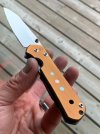Lately I was trying to figure out how to anodize titanium successfully. But sadly I failed. I watched a lot of YouTube videos and read a lot about this topic on the internet and I still did not find the solution for my problems.
What I use and how:
-DC power supply (0-120V, 0-3A)
-electrolyte: TSP in distilled water or vinegar essence (pure or mixed with distilled water)
-cathode: stainless steel bowl
-anode: titanium grade 5 (every part I tested)
-I do not etch the surface of the titanium before anodizing but I sand the surface before and clean it with glass cleaner.
The problems:
1. The pitting:
Sadly I experience a lot of pitting on the titanium while anodizing. I experience it with vinegar and TSP as an electrolyte, with tiny and big parts and with big and minimal amounts of TSP or vinegar. Through a lot of hours of testing I found out a few interesting things:
-Always when the pitting starts the titanium does not reach the desired color and the showed amps on the power supply do not drop to 0.
-The less TSP I use in the distilled water the later the pitting begins. (with "later" I mean higher voltage) Even when I use almost no TSP (1ml of TSP in ~1l of water) I experience pitting in the higher voltages.
-When the titanium is submerged and I turn up the voltage very slowly the pitting sometimes appears later or not at all. However sometimes it still comes to pitting.
-I do not see a big difference if the power supply is turned to around 1 or 3 A.
2. The dull colors:
An other problem that I experience are the dull colors. The colors from 0 to 40 volts seem to be reasonable. But all the colors above that are a lot duller than they could be. Maybe you think that that happens due to not etching the parts. But that is actually not the case. I know that brighter colors without etching are possible. (more on that later)
"Mysterious" phenomena:
-Sometimes when I test anodizing a titanium wire every thing works perfect. Even the colors in the high voltages are bright and beautiful. But later when I test an other piece of the same wire with the exact settings it etches again and looks bad.
-Sometimes the parts do not etch (but they still look dull) when I slowly turn up the voltage but sometimes the do.
Hopefully someone has an idea for a solution. I appreciate every little help.
What I use and how:
-DC power supply (0-120V, 0-3A)
-electrolyte: TSP in distilled water or vinegar essence (pure or mixed with distilled water)
-cathode: stainless steel bowl
-anode: titanium grade 5 (every part I tested)
-I do not etch the surface of the titanium before anodizing but I sand the surface before and clean it with glass cleaner.
The problems:
1. The pitting:
Sadly I experience a lot of pitting on the titanium while anodizing. I experience it with vinegar and TSP as an electrolyte, with tiny and big parts and with big and minimal amounts of TSP or vinegar. Through a lot of hours of testing I found out a few interesting things:
-Always when the pitting starts the titanium does not reach the desired color and the showed amps on the power supply do not drop to 0.
-The less TSP I use in the distilled water the later the pitting begins. (with "later" I mean higher voltage) Even when I use almost no TSP (1ml of TSP in ~1l of water) I experience pitting in the higher voltages.
-When the titanium is submerged and I turn up the voltage very slowly the pitting sometimes appears later or not at all. However sometimes it still comes to pitting.
-I do not see a big difference if the power supply is turned to around 1 or 3 A.
2. The dull colors:
An other problem that I experience are the dull colors. The colors from 0 to 40 volts seem to be reasonable. But all the colors above that are a lot duller than they could be. Maybe you think that that happens due to not etching the parts. But that is actually not the case. I know that brighter colors without etching are possible. (more on that later)
"Mysterious" phenomena:
-Sometimes when I test anodizing a titanium wire every thing works perfect. Even the colors in the high voltages are bright and beautiful. But later when I test an other piece of the same wire with the exact settings it etches again and looks bad.
-Sometimes the parts do not etch (but they still look dull) when I slowly turn up the voltage but sometimes the do.
Hopefully someone has an idea for a solution. I appreciate every little help.

